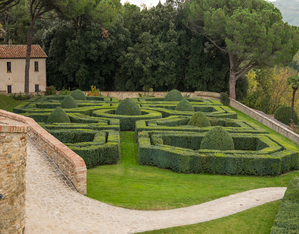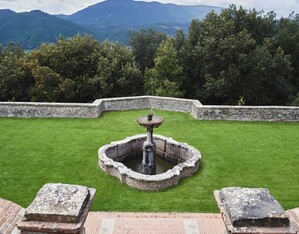Fortified structures and Baroque wonders harmoniously blending in a castle whose park and two small gardens, nested between battlements and sentry boxes, give rise to diverse atmospheres.
The word Castello(castle) refers to the fortified image that still distinguishes the complex, built on a spur of rock in a strategic position overlooking the Tiber Valley, in an area that was for a long period of time the scene of bitter conflict between the Perugini and Fortebraccio’s militia, and between the powerful Oddi and Baglioni families; but the interesting aspect of this architecture lies in its refined Baroque “imitation” of a fortress that marked its transformation when the property was acquired by the Antinori Marquises who turned it into a villa. The composite arrangement of the property’s open spaces, squares, and gardens dates to the second half of the 18th century. The expansive, sunny and panoramic, square-shaped elevated cobblestone and brick floor courtyard is the heart of the elegant 18th-century composition. A double flight of stairs leads to the walled garden below with a multi-lobed fountain at the centre. At the back of the property, a shady holm oak garden with its varied and visually effective colour play appears as a large green hemicycle lined by two annular pathways lined with pine trees. In the villa-castle is also home to a beautiful “Italian-style” formal garden with sinuous boxwood garden beds that was created in the 19th century inside the ramparts, by the walls, along a “oblique” axis compared the villa. The long main avenue leading to the villa lined with maritime pines is regarded as one of the most beautiful in Umbria.




